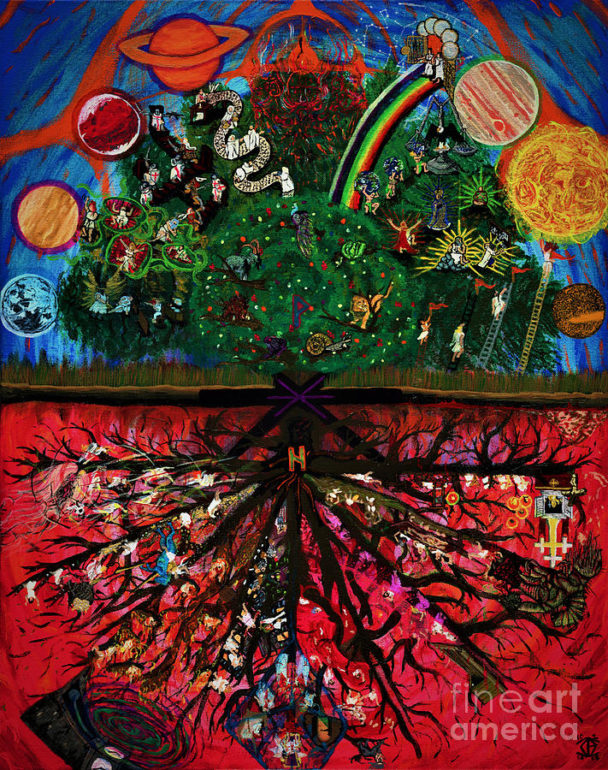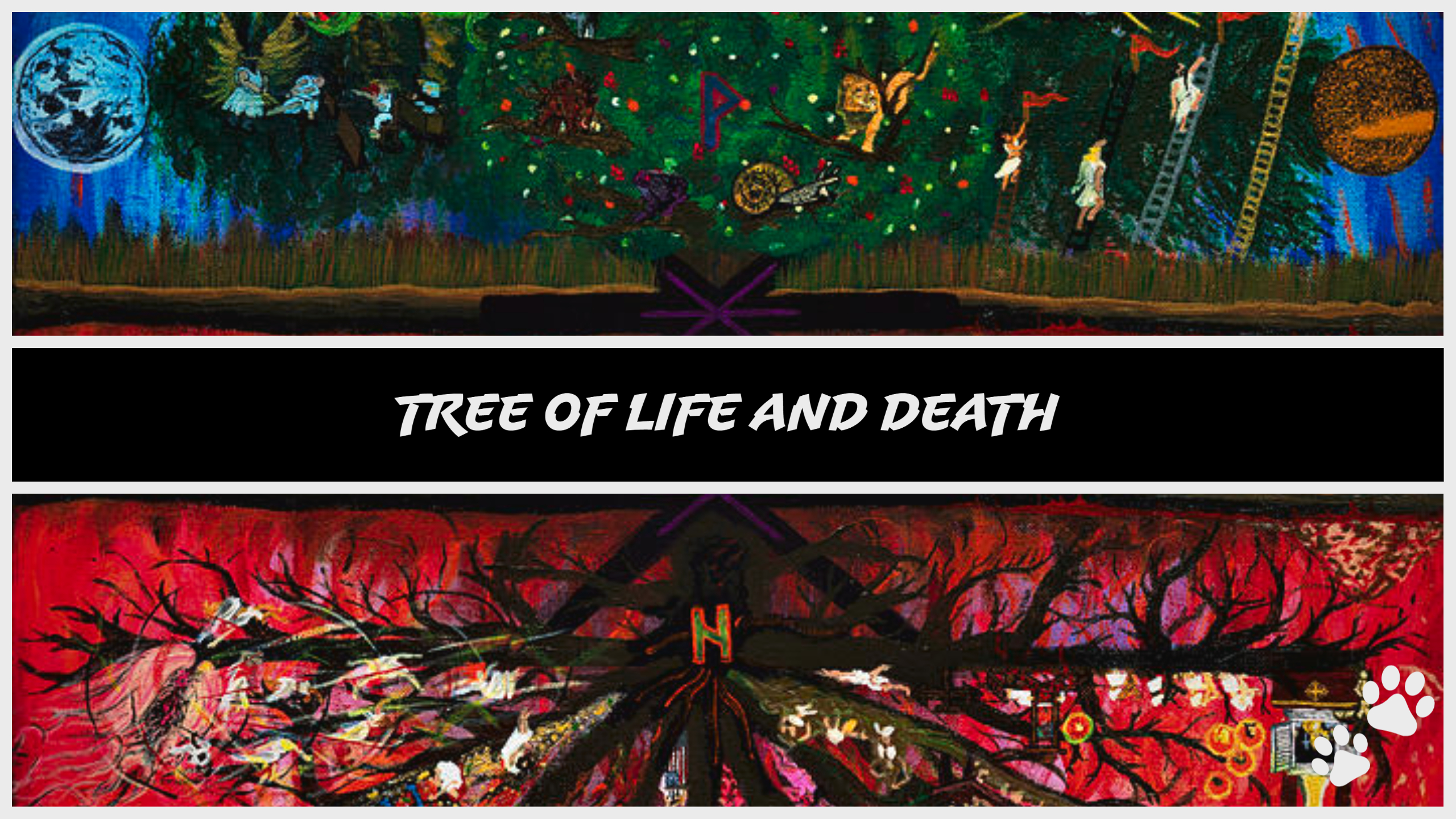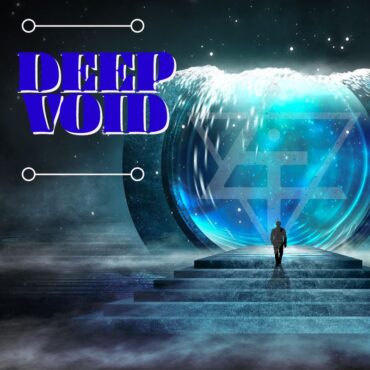-
play_arrow
New 365
-
play_arrow
KTLK-dB RADIO ONLINE 24/7

–written by Anthony Tyler–
After releasing the first excerpt from my book “Dive Manual”, the excerpt focusing on sleep paralysis, Jungian psychoanalysis and demonology, I figured I could at least release one more. Aside from sleep paralysis, the Trees of Life and Death throughout history and comparative religion are a topic in my research that has raised some of the most interest.
And, since the entire excerpt has everything to do with their explanation, I’ll leave it at that and invite you to read down below for more info!
Lots of Jung, demonology, divination, and chaos theory.
And if you like the excerpt, make sure to pick up a copy of my book to learn more on this subject and a whole lot more: https://www.amazon.com/Dive-Manual-Empirical-Investigations-Mysticism-ebook/dp/B084R8PTYW
___
Kabbalah is said to be the ancient mystical doctrine of Israel—inspired heavily by the Egyptian Mysteries—and the Tree of Life was its most sacred concept. If Jung proposed irreducible archetypes in the mind, the circular fixtures on the Tree of Life, known as the sephiroth, are the irreducible archetypes of the world that relate to the mind. Considered as an anatomical diagram of “God’s body”, each sephirot is allegorically considered as a piece of the body, and it is axiomatic to understanding how mythological esoteric symbolism has very literal archetypal qualifications. By using what is now known as chaos theory and memetic theory, the ancient theologians of the mysteries hypothesized that “as above, so below” and that if man was the effect of some cause, then studying this effect would help them further define the cause.
There is little doubt that the Tree of Life was largely inspired by the Egyptian Mysteries. Egyptian mythology has a great deal to do with alchemical symbolism, equating god’s growth of the human to the sun’s growth of a plant. The only real question is whether the ancient Hebrew were the first to come up with the diagrammatical system that is known today as the Kabbalistic or Qabbalistic Tree of Life, or whether this was something they picked up from the Egyptians.
Kabbalah is used specifically in reference to ancient Judaism, while Qabbalah is considered the renaissance and post-renaissance incorporation of these ancient Judaic principles into the full body of esoteric knowledge, specifically Rosicrucianism (essentially a form of Christian alchemy) and Hermeticism. Qabbalah is considered a large precursor to today’s new age movement, and this can make it easy to toss the baby out with the bathwater here, but it is extremely important to remember the extensive history that Qabbalah has within the western esoteric tradition, having been a staple for deciphering esoteric symbols since the medieval renaissance.
The Bible marks in Genesis that the Tree of Life is the source of eternal life and it is believed by some Christians that Christ was to represent the very fruit of the Tree of Life, since he was “of the body of God” by being His son. The Norse as well had a depiction of this very tree, Yggdrasil, that is nearly identical to the Judaic version in archetypal function. The Greek Neoplatonists were heavily involved with dissection of the Tree of Life, calling it the Tree of Porphyry. Buddha sat underneath the bodhi as he meditated and transcended beyond the deepest layers of his karmic barriers, even being tempted by Mara the demoness. In Islamic tradition, the Tree of Immortality, i.e. the Tree of Life is the only tree present in the Garden of Eden. The Persian mystery rites of Zoroastrianism called the tree Haoma. It can also, not very surprisingly, be found in varying but equal archetypal degrees in Native American mythology.
As for myself, since I have framed this as a discussion of Hermetic Qabbalah, allow me to state that my personal favorite rendition of these principles is found within Dante’s Divine Comedy. It is here that I may claim my innermost connection to these ideas, although my personal connection doesn’t end there.
The tree allegories such as the tree of life, of death, and of knowledge eventually became the allegories for the humanistic implications of agriculture, horticulture, and even medicine, among other things. The apocryphal Book of Enoch from the Bible has some very interesting and vivid descriptions of these ideas and how they affected humankind to come, claiming that the Nephilim were the ones to teach humanity about the classifications of plants and how to use them. Soon upon reading, it can be seen why this book was left out of the standard Bible—Enoch’s story is very much a symbolic wedding of the traditional pagan mysteries with fundamental Christian theology. There is a strict tone of condemnation within the book, consistent with other biblical writings, but it simultaneously emboldens certain pagan concepts of theurgy, for example, as Enoch intentionally communes with angels and acquires special knowledge through his efforts. And, as most of us already know, special knowledge is generally frowned upon in Christianity for its relationship to the bite of the apple from the tree of knowledge.
Regarding the Tree of Life itself, it is daunting and somewhat impossible to entirely summarize all its aspects, but suffice it to say that it is something similar to the Graphics Processing Unit of the cosmos’ computing hardware, because it has literal physical implications as well as psychodynamic. Overall, the tree represents transpersonality, which is the threshold of personality found within the unconscious mind. Since the human being once existed without personality as it is defined today, these states of non-personal awareness still exist in the mind and serve as operant mechanisms or software programs for self-identity. And, since, when we specifically speak about human states of consciousness it means that the mind and environment are hardly separate, the Tree of Life in turn shows us operant mechanisms of our environment through how they are archetypally transposed onto the psyche. In other words, the Tree of Life is a symbolic, even heuristic network meant to map the individual human psyche’s relationship to its overall adaptation as a species.
The Tree is separated by two pillars on either side, the left being the Pillar of Severity and the right being the Pillar of Mercy. Decorating the tree are ten spherical sephiroth which denote the ten most archetypal and irreducible manifestations of existence, notably bearing a positive, idealistic nature— hence their depiction as the anatomy of God. The Pillar of Mercy holds the second, fourth, and seventh sephiroth, and the Pillar of Severity holds the third, fifth, and eighth. Down the middle are the first, sixth, ninth and tenth. The Tree essentially serves as a filing system for archetypal symbolism, with ten essential folders for filing a countless number of esoteric symbols. By degrees of separation, essentially any esoteric symbol can be classified under the Tree of Life (or Death) with a bit of research. The dynamics between these trees can be related to the Yin and Yang but represent an infinitely more complex web of symbolism.
First listed is the name of each specific sephirot, followed by its planetary correlate, its archetypal descriptions, then the correlates to Dante’s Divine Comedy. It is likely that you will find more and more use of these categories as the book progresses.
I. Kether – Neptune [originally Jupiter] – Supreme Crown; the unknown, transcendent point; “the most hidden of all things” – Dante’s Ninth Sphere of Paradise: The Primum Mobile (Angels)
II. Chokmah – Uranus [originally Saturn] – Wisdom; the seed – Eighth Sphere of Paradise: The Fixed Stars (Faith, Hope & Love)
III. Binah – Saturn – Understanding, discernment, transmutation – Seventh Sphere of Paradise: The Contemplators
IV. Chesed – Jupiter – Mercy, grace, divine love; the “bridge over troubled waters” – Sixth Sphere of Paradise: The Just Rulers
V. Geburah – Mars – Severity, power, judgement, the consequences of actions – Fifth Sphere of Paradise: The Warriors of Faith
VI. Tiphareth – the Sun – Beauty, glory, the humility and comfort of truth – Fourth Sphere of Paradise: The Wise
VII. Netzach – Venus – Victory, endurance; that which is ceaseless – Third Sphere of Paradise: The Lovers
VIII. Hod – Mercury – Splendor, majesty; mystery of forms and organization of those forms —Second Sphere of Paradise: The Ambitious
IX. Yesod – the Moon – Foundation, that which can bring something from one condition to another, like the waves of the ocean; connection – First Sphere of Paradise: The Inconstant
X. Malkuth – the Earth – Kingdom, the steps towards Heaven, roots firmly supplanted – Mount Purgatory, River of Lethe
Pluto is often fit into the symbolism with Da’ath, which is the zero-point where all the sephirot are united as one in a state of primordial unbeginning—or the absence of the beginning. If one prefers a metaphor, Da’ath is like the theoretical point of existence right before the Big Bang.
It should be noted that in the Divine Comedy, Dante meets God after transcending the Tree of Life from the Kether sephirot, meaning that if the tree is the body of god, then beyond the tree is god’s mind, its personality or transpersonality. Ultimately, the Tree of Life is a map of a human’s relationship with the divine, and while there is a masculine quality to this tree, the “mind of God” entirely transcends even archetypal femininity and masculinity.
The Tree of Death holds the ten qliphoth instead of sephiroth. Instead of God presiding over this Tree, most occultists place the classical Hebrew demoness, Lilith, as the Queen of the qliphoth. Traditional Kabbalistic studies placed Lilith as the first woman given to Adam by God, not Eve, and she was said to become a corrupter of humankind, especially men, ever since. Her first appearance in religious and folkloric symbolism is through the Babylonian Talmud, but her archetype can be seen wherever religious systems have developed.
There will be plenty more on Lilith and her synonymous archetypes to come, but for now it is extremely important to note the feminine touch to the Tree of Death. As discussed prior, mystery, darkness, and femininity are the classic symbols for the unconscious mind, whereas profundity, lightness and masculinity are associated with the conscious mind. Remember that this is not any grounds for misogyny, especially when read in proper context of modern physics and the sacred alchemical marriage of the psyche. Both the symbolic feminine and masculine are equally divine as they are demonic.
Demonology, the circles of hell, and so forth, are meant as symbolic units of psychological distance between the human and a healthy contentment or a divine inspiration. Every individual must come to terms with both their archetypal feminine and masculine, and the sacred alchemical marriage that occurs when we become reacquainted with them both. For the man, his depolarization is found within his quest for the anima, his inner feminine archetype—for the woman, her depolarization is found within her quest for the animus, her inner masculine archetype. However, recognizing the masculine and feminine archetypes within each individual is the key. Without recognition of the polarity, depolarization cannot occur.
So, that Lilith is the demoness of the Tree of Death naturally implies a sense of un-union with the sacred masculine, thus the calm waters of the unconscious mind become a turbulent storm. Conversely, that “God’s body” represents the Tree of Life naturally implies the harmonious union of the archetypal masculine with the feminine. It is important to emphasize the archetypal specificity with these terms, so as not to falsely assume misogyny or patriarchy. As a quick summary of this point, God is the transpersonal alchemical union of the psyche. Adaptation. This is, of course, a reductionist way to look at it, and surely there is more to be said about the symbolism of God, but that He symbolizes the psyche’s adaptation principle is inarguable. Likewise, the Tree of Death is not a damnation of womanhood, it is an expression of what happens when the archetypal femininity within is unloved, unkept. It is a warning to heed.
It is here that I will also state that I am not presenting the Tree of Death as some fixed state of hell that souls are damned to after death (nor am I saying this of the Tree of Life and heaven)—this tree is a representation of the human’s separation from the mystical transpersonal state termed as God. Take as an example the allegory of the regular tree during winter—its leaves fall, and it becomes a skeletal, dead version of what it used to be. But winter is not evil—it is harsh and unforgiving—and the tree is only in a stasis, reserving its energy for the day when it will finally be allowed to flourish to its fullest extent. Succumbing to winter is death, but winter also promises summer if dealt with accordingly. But rest assured, that the pressures of poverty in winter will cause a person to commit plenty of evil, just like a great day at the beach is likely to make anyone feel just a little better about life.
That the Tree of Life is represented by the masculine quality of God and that the Tree of Death is represented by the feminine quality of Lilith does not mean that both these trees are exclusive to either the conscious or unconscious realms of explanation. The key is understanding that the Tree of Life, in documented ways, also describes the inner relationship that nature has with itself.
The Tree of Death does no such thing. It is purely an expression of the human. The Tree of Life innately implies a synthesis of man with nature, and the Tree of Death implies total maladaptive dissent. It is the worst-case scenario that occurs when a human has fallen into their own inner chasm and shut themselves off from the outside world.
The idea of the Tree of Death is a practical evolution of concept that has, in a sense, been around as long as the Tree of Life itself. But in literal terms, the origins of the qliphoth can be dated to the 16th century-era of Kabbalistic mysticism. Rabbi Isaac Luria is one of the foremost acknowledged progenitors of the Tree of Life into less of a fragile secret, and more of an idea worthy of literature and philosophical conjecture. He was, of course, only one of many voices.
In Luria’s writings, there can be noted the concepts of the “shells” of existence that remain as a type of barrier that must be traversed to ascertain any wisdom from the sephirot that the shell encapsulates. The qliphoth are these “shells” of the sephiroth, also called “anti-poles”. However, while the Tree of Death was instigated by classical Kabbalists, it was not fleshed out into an inverted model of the Tree of Life until the spike of 20th century western occultism.
This is a table I have developed through the study of the different authors on the subject and it is meant to be an introductory table into the symbolism of the qliphoth. The Tree of Death is a bit more open for interpretation than the Tree of Life, and some authors disagree on minor details of the symbolism in certain cases, but it is the overall context of the symbolism and what it represents that is of importance, and the titles themselves are lesser.
First listed is the name of the qliphot; the second listed is the “demon” which resides over the qliphot. The third listed is the corresponding circle of Hell that Dante’ traversed in the Divine Comedy. The fourth listed is the sephirot of the Tree of Life. The definitions of the qliphothic shells are to be taken as the exact opposite, inverted interpretations of the sephirot that they encase. These are the dissociated states of our psyche, the winter of the soul—the waves of the unconscious mind’s deepest waters.
This is what happens when your shadow gets a grip of you and doesn’t let up.
I. Thamiel – Moloch – the twins of God – Treachery – Kether
II. Chaigidel – Beezlebub – the hinderers – Fraud – Chokmah
III. Sathariel – Lucifuge Rofocale* – the hiders – Violence – Binah (*not to be confused with Lucifer.)
IV. Gamchicoth – Ashtaroth – the devourers – Hersey – Chesed
V. Golachab – Asmodeus – the flaming ones – Wrath – Geburah
VI. Thagirion – Belphegor – those of grief and tears – Greed – Tiphareth
VII. Harab Serapel – Baal – the ravens of dispersion – Gluttony – Netzach
VIII. Samael – Adrammelek – the false accuser – Lust – Hod
IX. Gamaliel – Naamah (some place Lilith here) – the obscene ass – Limbo – Yesod
X. Nehemoth – Lilith (some place Naamah here) – the woman of the night – Mount Purgatory / River of Lethe – Malkuth
Pluto and its symbolic associate, Da’ath, have the anti-pole of Belial, representing worthlessness.
In The Kabbalah Unveiled, by SL Magregor Mathers in the early 20th century, we find consideration of the qliphoth: “The demons are the grossest and the most deficient of all forms. Their ten degrees answer to the decad of the Sefiroth, but in an inverse ratio, as darkness and impurity increase with the descent of each degree. The first two are nothing, absence of visible form and organization. The third is the abode of darkness. Next follow seven Hells occupied by those demons which represent incarnate human vices, and torture those who have given themselves up to such vices in earth-life.” [p. 30]
It is here that we find more distinct correlates to Dante’s Inferno. Not only was Dante’s Divine Comedy dealing with the inversion of life and death, heaven and hell, encapsulating the very same dichotomy of the Trees of Life and Death, but it played a historically critical role in detailing the human’s personal relationship to all this information.
It is commonly taught that the highest sephirot on the Tree of Life, Kether, is within the lowest sephirot, Malkuth, and that they represent a continuum—a feedback loop, something like a mobius strip. Since it is suggested that the Trees of Life and Death are connected at their “roots” or “base”, it is deduced that the sephirot Malkuth and its anti-pole, Nehemoth are like the symbolic entrances to Heaven and Hell, and that they are both accessed by way of the material realm. This symbolic conclusion seems to have the same archetypal implications as that of classical karma. Malkuth, representing the material realm, is the only sephirot that is said to not emanate from “God” directly, although it is a crucial part of the Tree’s function all the same. This separation from the concept of divinity that Malkuth has is a further emphasis on learning the spiritual through the material. It is for these reasons and more that I assert that Dante’s Mount Purgatory, with the River of Lethe (forgetfulness) at the mountain’s summit, within the Garden of Eden, represents Malkuth/Nehemoth for it is both the entry to Hell from earth, and symbolically it is the closest material threshold to Heaven. Since this symbolism seems to fit quite seamlessly, Dante’s Nine Circles become “Ten Realms”, if you will, and the synthesis of the Divine Comedy with the classical Tree of Life is completed. The physical realm is diagrammatically sandwiched in between the Trees of Life and Death, depicted as the roots. As we make our psychodynamic path through the qliphoth, we become entirely engulfed by the psyche’s shadow, and we find ourselves in Hell. If we succumb to the qliphoth, we are separated from a sense of unity entirely and, we fall into the abyss, where we are no longer in a battle with our defense mechanisms and neurosis, we are ruled by them.
When we remember that Faust is a compendium of Gnostic alchemical symbolism that borrows symbolism from the Divine Comedy directly, we begin to see a web of interconnected esoteric, archetypal symbolism that serves as a possible psychoanalytic codex with limitless potential for investigation and observation. If this model can be applied to psychodynamic analysis, and even to clinical or auto-hypnotic sessions, I assert the results would be profound on a consistent and reproducible level.
Suffice it for now to say that I propose the Tree of Life as a necessary symbolic codex to understanding the transpersonal, cryptogrammatic aspects of the mystical experience and catharsis overall. I, however, do not recommend at all that the Tree of Death be used during hypnotic sessions, although some darker branches of western esotericism do so anyway. The qliphoth are not meant to be symbolic suggestions of the psyche but are diagnostic tactics to help us pinpoint our current position to the Tree of Life.
To explain, I present the allegory of the shoreline, the land being the angelic archetypes and God itself, and the waters being the demonic archetypes of mystery and monsters. Human society and culture would not be what it is today without oceanic travel, but during a nautical adventure, navigation is entirely crucial, and too much time away from land will mark a traveler for death. Stranded at sea, a person will succumb to any number of physical and mental declines until they are no longer able to carry on. Therefore, the Tree of Death represents the waves of the ocean and the implications of its deepest depths, while the Tree of Life represents land—and they connect at the shoreline of the individual psyche. As important as the ocean and its depths are, let us not forget our maps toward land or how to read them properly. While the Tree of Death is purely diagnostic, the Tree of Life is pure psychodynamic medicine that one cannot overdose on.
Lastly, remember that in classical instances, these trees were not just meant to signify spaces of the unconscious mind. They were meant to also symbolize the realms that the soul can visit after death, and the correlating states of psyche were meant to signify the quickest ways to get a person there. In turn, these realms after death were meant to symbolize spaces where a soul might stay indefinitely, so to study with divinity and make its preparations for its next encounter with earthly karmas. These ideas are heavily influenced by philosophies of the Neoplatonic and Neopythagorean variety, as we shall see ahead.
So, even if you don’t believe in a literal God or Devil, it might be wise all the same to ponder how they might be affecting you from an adaptational standpoint.
Transpersonality, ultimately, is the ability to consider whether one is adapting properly, and this state of self-reflection seems to be almost entirely lost within postmodern society…
___
Thanks for reading! This marks the end of the the excerpt, so if you like what you read, grab a digital, paperback or hardcopy here: https://www.amazon.com/Dive-Manual-Empirical-Investigations-Mysticism-ebook/dp/B084R8PTYW
Written by: Anthony Tyler
Caballah Esoteric Etsa Chayim Kaballah Kabbalah Methaphysics occult Spirituality Trree Of Life
Similar posts
Become an Outsider and stay up-to-date with all things fringe
Contact Us
- +1 501 777 5631
- [email protected]
- DMCA Notification
COPYRIGHT FRINGE MEDIA GROUP LLC





